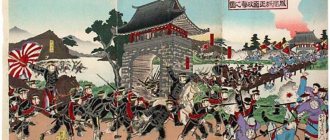Sino-Japanese War (1894-1895)
In 1876, Japan began the “discovery” of Korea in much the same way that the Americans “discovered” Japan itself. In Korea, she entered into an acute conflict with China, which led in 1894-1895. to the Sino-Japanese War. The battle between the two largest Far Eastern states ended in a decisive victory for Japan, which now became a leading regional power.
Japan captured Taiwan, gained its "zone of influence" in China and forced it to give up all rights to Korea. The huge indemnity received from China accelerated the industrialization of Japan and the development of its military industry. At the same time, a revision of old unequal treaties began, thanks to which Japan soon acquired equal rights with the Western powers in international relations and in world trade.
The main challenges in Japan's domestic policy
Overcoming the international crisis is the main goal of members of the world community. In the process of achieving the required result, most actors face internal and external challenges that significantly limit the ability of states to implement the appropriate set of measures. In this matter, Japan is no exception. The start of the election race between Shigeru Ishiba, Fumio Kishida, Yoshihide Suga, acting as the main candidates, should reveal which of the contenders has the greatest support among the main factional forces in the Liberal Democratic Party (LDP). Members of the world community will be able to find out the name of the next prime minister no earlier than September 14, after the voting procedure has been carried out. The immediate actions of Abe’s successor will determine the future path of Japan’s development. It is worth emphasizing that in the near future the new chosen one will have to resolve the issue of measures to eliminate the economic consequences of the pandemic and stabilize socio-economic activity, taking into account the preservation of the current epidemiological situation.
However, in the future, issues related to the reduction of the working-age population, the unfavorable demographic situation, improving working conditions, natural disasters, and increasing energy dependence will become of greatest relevance on the domestic political agenda.
Representatives of the ruling coalition, most of whom are members of the Liberal Democratic Party, are aware of the significance of the challenges facing the state. Accordingly, the final choice of one of the three candidates on September 14 should show how capable Tokyo is of countering the relevant threats.
Russo-Japanese War (1904-1905)
The intensification of Japanese policy in Korea and northern China led to a worsening of relations with Russia. In preparation for war with her, Japan concluded an alliance treaty with Great Britain in 1902 and enlisted the tacit support of the United States.
Victory in the Russo-Japanese War of 1904-1905. brought Japan control over Korea and southern Manchuria, Russia ceded to it its naval base of Port Arthur and half of Sakhalin. The resounding victory increased Japan's prestige on the world stage, especially among the peoples of Asia. At the same time, the war with Russia required extreme effort from Japan and undermined its economy. The Prime Minister of Japan wrote at the end of the war: “At present, literally everyone, from rickshaw pullers and cab drivers to small traders, is talking about the lack of livelihood.”
Popular
INTRODUCTION
The topic of the influence of big capital, monopolies, financial corporations on the domestic policy and foreign policy decisions of the state, as well as on the directions of its main vector of development, remains relevant today.
Thus, in an effort to protect the economic interests of big business, the governments of many countries:
- build up military power;
- increase the militarization of production;
- spend huge amounts of money on maintaining military contingents in the country and abroad;
- use force as a means of putting pressure on political rivals and opponents.
This tactic is typical for many modern developed countries that actively participate in local conflicts and armed confrontations primarily with the aim of extracting maximum economic benefit [12; 98].
Using the example of Japan at the end of the 19th century. – beginning of the 20th century the following can be traced: is it realistic to achieve the solution of foreign policy goals in their long-term perspective, forcing the country’s economy to work for the needs of the army [8; 143]. Thus, during this period, the state in question achieved long-term economic growth largely due to the implementation of an aggressive militaristic policy.
THE PATH FROM A SEMI-FEUDAL STATE TO A POWERFUL POWER
After a long period of isolation, until the 70s of the 19th century, Japan consisted of disparate semi-feudal principalities that often conflicted with each other, which had a very negative impact on the development of capitalist relations [3; 73]. However, with the formation of a unified Japanese state, the era of bourgeois transformations began and, as a result, as a result of the reforms carried out during that period, it was possible to stimulate the development of both small and large industrial national production [10; 119].
Being a formally independent state with an agricultural economy, Japan began colonial aggression against other countries, which gave it the impetus to complete the industrial revolution [7; 95].
Since the 1870s A new cultural, political and economic vector of development of the land of the rising sun began to take shape. Japanese capitalism, which was emerging at that time, acquired imperialist forms, and the monopolization of the national economy turned Japan from a weak, semi-feudal state into a country with the highest rate of economic growth at that time, a powerful army in the Far East and a modernized fleet, not inferior in strength to the British one.
Monopolies of a specific form that arose during the transfer of state property into private hands and controlled the banking and industrial associations that existed at that time - “zaibatsu”, received many preferences and were able to reorient themselves from trade and credit operations to investing in heavy industry [9; 114].
In addition, the state planned the construction of “model enterprises” in the field of metallurgy, mining and other industries, created according to foreign analogues. However, the efficiency of their work remained low, as a result of which the government authorized the transfer of unprofitable enterprises to zaibatsu monopolies at a price more than 2-4 times lower than their real market value [10; 120].
Despite the rapid growth of heavy industry in 1870–1890, its share in the Japanese economy was a relatively small share, while light industry, including textiles, remained much more developed. Thus, small industries and craft workshops predominated in the country, and the industrial proletariat at that time constituted only 0.87% of the country's population.
At the same time, the development of capitalist relations and the industrialization of the country did not contribute to improving the well-being of broad sections of the Japanese population. A high land tax, amounting to about 50% of a peasant's income, and extremely low wages at enterprises left consumer demand within the country at an unacceptable level. [5; 129]
In order to overcome the limited domestic demand and the weakness of its own industrial and raw material base, the state chose the direction of militarizing the economy. As a result, a redistribution of political forces in the ruling bloc and the formation of a new foreign policy began [13; 5].
FOREIGN POLICY OF JAPAN AT THE BEGINNING OF THE XX CENTURY
30 years before the start of the confrontation with China, Japan managed to increase the number of ground forces 10 times - up to 170 thousand people. Shipbuilding also received significant development, as a result of which Japan became the owner of the strongest fleet in the Far East, and by 1883 its naval forces included 42 ships. [2; 51]
In addition to creating a regular army and strengthening the navy, the government was engaged in the formation of a special ideology that promoted the racial exclusivity of the Japanese nation . The military began to acquire increasing influence and importance in ruling circles and in society as a whole, and the chosen course of strengthening the army and implementing foreign policy through expansion found support in large trading houses interested in opening new markets for the export of goods from foreign countries.
Thus, having significantly increased its military potential, Japan rushed to territorial redistribution in Asia, where it had to face Korea, China and Russia. [6; 107]
Having begun the economic conquest of Korean markets, the land of the rising sun faced serious opposition from China, as a result of which, starting in 1890, the position of Japanese traders gradually deteriorated. Naturally, this state of affairs ran counter to the ambitions of the Japanese government, but in order to implement aggressive plans in the life of Japan, a significant reason was required, which subsequently presented itself.
Thus, in 1894, Japan sent in its troops under the pretext of pacifying the rebellion in Korea, thereby provoking a long-simmering conflict with China. As a result, thanks to threefold military superiority, Japan won and forced China to capitulate , and the resulting indemnity of 350 million yen was almost entirely directed towards measures to further militarize the Japanese economy. [6; 112] Their implementation also ensured Korea's free access to imports and equal rights with other countries to trade in China. Thus, in the next 10 years there was an extraordinary rise in the Japanese economy, and the “zaibatsu” received huge profits due to the war , which received the status of predatory.
In addition, the financial crisis of 1900-1903, which hit small businesses, contributed to mergers and acquisitions, resulting in a process of concentration of production in the hands of large capital. Thus, after the Sino-Japanese War of 1894-1895. the capitalization of the Zaibatsu monopolies almost doubled in 10 years.
Such rapid development was ensured by stable close ties between the heads of trading conglomerates and political authorities, which allowed them to achieve favorable conditions in both domestic and foreign markets [9; 114].
The key difference between the Japanese zaibatsu and the European and American monopolies was their interest in the colonial orientation of Japanese imperialism . Comprehensive support for the state in its militaristic endeavors from the Japanese monopolists and the joint suppression of numerous peasant uprisings made it possible to pursue foreign policy without regard to the degree of discontent of the population [11; 9].
Thus, having crushed the Korean economy and humiliated weak China, which was only the first stage of expansion in the path of Japanese aggressive policy, Japan took a further course towards preparing for war with Russia [7; 101].
Proponents of decisive military conquest developed a ten-year plan of active militarization, according to which it was planned to double the size of the army and quadruple the navy, and this would require new factories, heavy industries and metallurgical plants.
The Japanese government needed a new war , for which it had been preparing for a long time and investing huge amounts of money (about 773 million yen from 1886 to 1903). Thus, by the beginning of the Russo-Japanese War, the formation of military command and control bodies was completed and the army was completely modernized [5; 132].
By 1901, Japan had become a state that directly influenced events taking place in the world. Japan participated in suppressing the rebellion that broke out in China along with such leading powers as Russia, the USA and England. However, it was China that became the stumbling block in relations between Russia and Japan, as a result of which attempts to delimit spheres of influence within the framework of peace negotiations turned into an expected failure.
Thus, according to the Japanese command, the territorial dispute that arose with the Russian Empire for control of Manchuria, Korea and the Yellow Sea could be resolved exclusively by armed means [12; 101].
After the Japanese victory in 1904-1905. There were no forces left above the Russian army in the Far East that could somehow resist the Japanese army. However, Japan’s economy was also exhausted to the limit by the war with the Russian Empire, as a result of which the country began to be threatened not only by an economic, but also by a political crisis . [eleven; 14]
The population, on whose shoulders all the burdens of the war were placed, actively opposed the continuation of armed hostilities. A decrease in wages, an increase in land tax, and the curtailment of non-military spheres of production - all this caused extreme discontent among the bulk of peasants and workers. As a result, Japan needed a period of recovery.
COLONIZATION, RELATIONS WITH THE USA AND ANNEXATION OF KOREA
As a result of the Russo-Japanese War (1904-1905), which lasted 17 months, Japan received Southern Manchuria, the Liaodong Peninsula with territorial waters, the southern part of Sakhalin, as well as complete freedom of action in Korea.
Japanese monopolies began to actively exploit the resulting regions , as a result of which national capital poured into China and Manchuria, concentrating in their hands about 60% of its imports, which marked the beginning of the construction of a new railway.
Thus, over 14 years, the invested capital increased almost 220 times . Japan's exports also increased, which made it possible to increase the amount of allocations for the further development of the military-industrial complex. Thus, in the post-war years, expenses for the Japanese army amounted to 36% of colonial income, while the same figure, for example, in England was 11%.
In addition to economic colonization, Japan also pursued an extremely tough annexationist policy towards Korea , as a result of which its political independence was first gradually destroyed, and then the national economy was rebuilt to meet the needs of Japanese concerns [7; 97].
Thus, together with Manchuria and Korea, a fairly large colonial state was formed, which was under the protectorate of Japan, but such a serious strengthening of the once weak state could not but alarm the authorities of the United States and other leading European states. While Japan managed to reach an agreement with Europe, a serious confrontation arose with the United States of America on numerous issues.
Thus, the Americans tried with all their might to prevent the final absorption of the Chinese economy by the Japanese “zaibatsu”, as a result of which the militarization of the Japanese economy was one of the means of preventing the emerging threat of the country losing its national independence, as well as a reaction to the desire of the United States and European countries to subordinate Japan to their own influence [13 ; 7].
Also, the Land of the Rising Sun introduced economic support for domestic traders, while representatives of other countries experienced administrative difficulties.
The situation gradually became tense, and in 1914 the United States and Japan were actually on the verge of armed confrontation , which was hardly avoided.
JAPAN IN THE FIRST WORLD WAR
Expansionist sentiments motivated Japan to participate in the First World War on the side of the Entente, as a result of which the country, which at that time was experiencing an acute shortage of foreign markets, became part of it under the pretext of membership in the military-political bloc.
Having become an ally of England, Russia and France in 1914, Japan, thanks to a modernized army of about 250 thousand people, was able to quickly recapture German New Guinea with the Mariana and Marshall Islands, as well as territories in the Chinese province of Shandong, thereby increasing its national wealth by 25% [1; 59].
Since at that time European countries and the United States of America were busy with military operations, Japan did not stop at capturing the German islands. Thus, on January 18, 1915, “21 demands” were put forward to China , which actually made the state economically dependent on Japan. As a result, not finding protection from the United States and England, the Chinese authorities were forced to accept this document in full.
Despite the fact that the Entente allies managed to achieve a partial softening of the enslaving agreement imposed by Japan, its weight in China, Korea and the rest of the Pacific region remained very significant [4; 107].
As a result, Japan in a short time managed to become one of the leading world leaders , a country with a powerful army, a modernized fleet and a developed monopolistic industry.
Undoubtedly, the main burden of such an aggressive foreign policy and unceremonious restructuring of economic, social and other spheres of public life fell on the shoulders of the Japanese people, brutally exploited for the benefit of imperialism and the boundless appetites of the zaibatsu monopolies. Ruinous wars, additional mobilizations, rising taxes and difficult working conditions - all this made up the life of ordinary citizens.
However, despite this, the Japanese, having taken the path of militarism, made a qualitative breakthrough in the economy, expanded the territory of the country and received their own colonies, which subsequently brought significant income to the state [6; 122].
CONCLUSION
The history of Japan during the period of wars and the policy of militarism shows that countries whose economies serve military needs and provide favorable conditions for the development of priority industries necessary for a powerful breakthrough are indeed developing rapidly and, as a result, significantly improving their geopolitical position.
However, from a historical perspective, this progress may be short-term in nature, since it is carried out mainly due to the overstrain of the basic sectors of the national economy and its one-sided development by pumping huge funds from one sector to another, usually associated with military production, the process militarization of the entire industry and brutal exploitation of the population [12; 98].
In addition, in the future, the policy of militarism can lead to a significant decrease in the general standard of living of the population, the gradual emergence of crisis phenomena in the economic, socio-political and other spheres, which, ultimately, will entail a deep systemic decline with the urgent need to carry out major remilitarization reforms in all areas.





